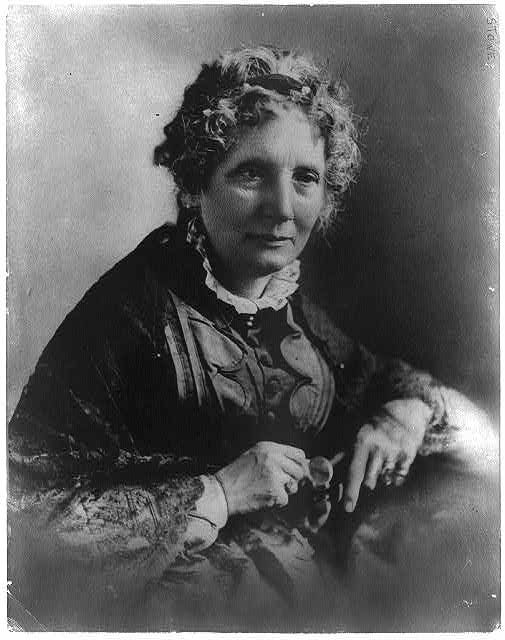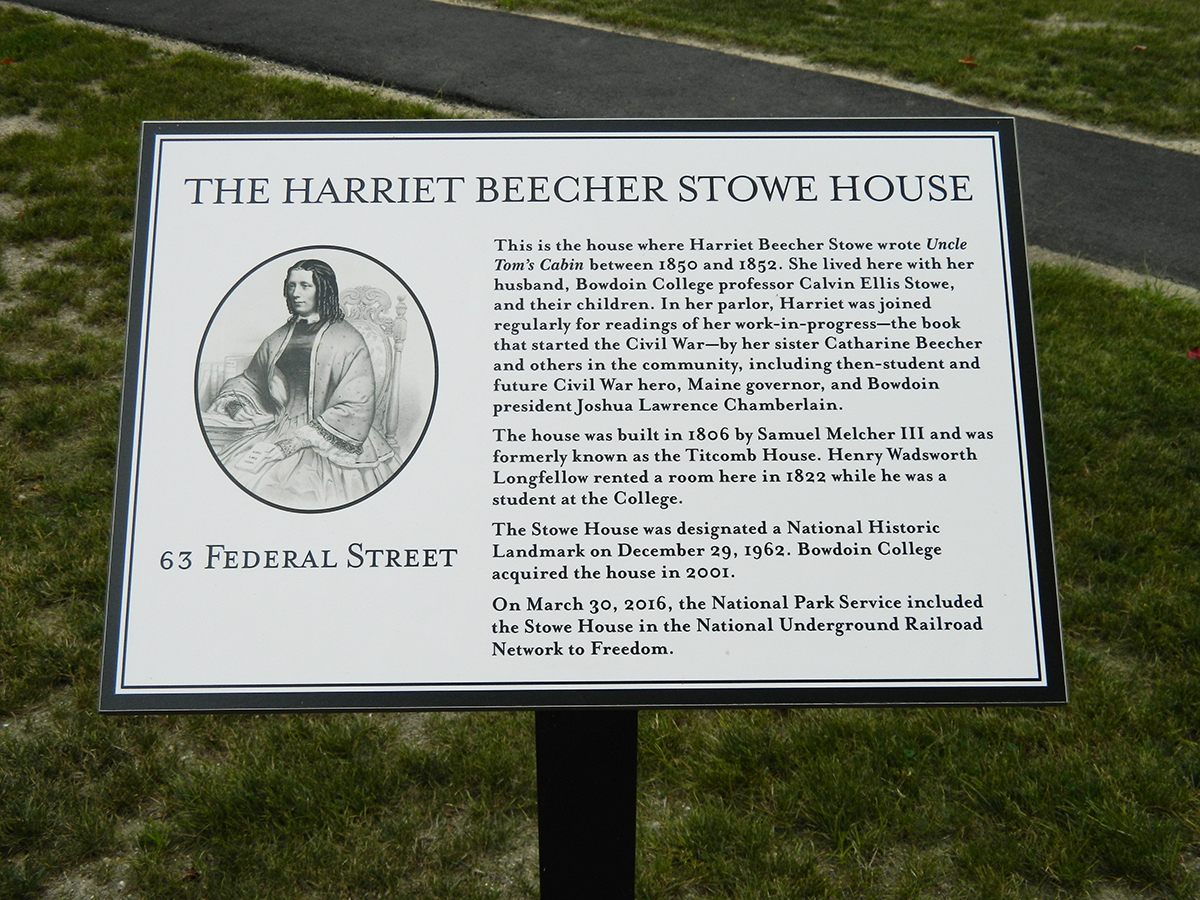The Battle Over Where ‘Uncle Tom’s Cabin’ Was Written
Everyone thought the matter was settled. Then a $3 million house hit the market in Brunswick, Maine.

The house in Brunswick, where the owners claim that Stowe wrote Uncle Tom’s Cabin. (Photo: David Jester)
When Harriet Beecher Stowe penned Uncle Tom’s Cabin, her residence was a drafty, colonial style home in Brunswick, Maine. For over a century, The Stowe House at 63 Federal Street has been touted as the location of where the famous anti-slavery novel was composed. That Beecher Stowe’s novel was written in this quaint Maine town is not in dispute, but in recent years, what residence gets to claim fame to it has been.
Over the last two years, a local family has challenged this bit of history. There is now ongoing litigation between them and Bowdoin College, which owns Stowe House.
Surrounded by the rapidly expanding campus of Bowdoin College, Arline Lay’s home is New England quintessential. Black shutters adorn crisp, white painted clapboard, and a white picket fence runs along the sidewalk. This house at 28 College Street, named Angel’s Home, is where the Lay family claims Uncle Tom’s Cabin was truly written.

The Stowe House at 63 Federal Street in Brunswick, Maine. (Photo: David Jester)
It wasn’t until 2014, when the house was put up for sale, that the claims of Harriet Beecher Stowe’s connections to the home became public. That year, Angel’s Home went on the market for a hefty price of $3 million, with just about every listing for the six-bedroom home mentioning its alleged connection to Uncle Tom’s Cabin. Historical significance or not, this was a surprising price tag for a sleepy town like Brunswick, especially in a downtown area, away from the ocean. (The home’s estimated market value is around $200,000, the Bangor Daily News writes.)
According to Elizabeth Burgess, collections manager at the Harriet Beecher Stowe Center in Hartford, Connecticut, there is no documentation that links Harriet Beecher Stowe to this home, and there is tangible evidence—through family correspondences —proving Stowe wrote at 63 Federal Street, as well as Appleton Hall at Bowdoin College.
But the Lay family asserts that Harriet Beecher Stowe actually wrote the lion’s share of Uncle Tom’s Cabin in a second-floor room at Angel’s Home. Family stories passed down through generations make up a large portion of their claim. These stories put Harriet Beecher Stowe upstairs in a rented room, during the early months of 1851. Beecher Stowe rented this room to escape everyday life and the distraction of her six children, the family contends.

Harriet Beecher Stowe, c. 1880. (Photo: Library of Congress/LC-USZ62-11212)
Their evidence for the home’s connection to the author is shaky, scholars say. Both Arline Lay, 86, and her cousin recall statements about Beecher Stowe renting a room there, made by a relative, Robert Peter Tristram Coffin, a poet and Bowdoin College professor. A small inscription in a pane of glass of an upstairs window, reading “Angel’s Home” (a reference to a song sung by Uncle Tom in the novel), was etched there by Arline Lay’s grandfather, James Coffin, to reflect Harriet Beecher Stowe’s tenancy there, they say.
Penned during the spring and summer of 1851, Uncle Tom’s Cabin became the watershed for abolitionist literature. Released in serial format, in the anti-slavery newspaper, The National Era, this book propelled abolitionist sentiment, and directed the minds of Americans, towards a United States free for all. This book spurred Beecher Stowe to international celebrity status, her book translated into 60 different languages.
Harriet Beecher Stowe only moved to Brunswick in the mid-19th century. In 1849 Calvin Stowe, her husband, accepted an appointment at Bowdoin College to the Collins Professorship of Natural and Revealed Religion. This set Beecher Stowe and her children on a journey from Cincinnati to Brunswick. In May 1850, after a month of traveling, they arrived at what was then called the Titcomb house, at 63 Federal Street, an 1807 house named after Benjamin Titcomb, a printer-turned-Reverend who struck off the first printed sheet of paper in the state of Maine.
“Son Charles Stowe’s 1889 biography, The Life of Harriet Beecher Stowe, which was heavily edited by Stowe herself provides evidence,” that they lived there, notes Burgess.

The plaque commemorating the house. (Photo: David Jester)
This home, only a short walk from Bowdoin College, already had an extensive literary history. Henry Wadsworth Longfellow resided there in the early 1820s, while attending Bowdoin college, and during this time befriended Calvin Stowe, future husband to Harriet Beecher. It was also at this house, in the late months of 1850, that the Stowe’s harbored John Andrew Jackson, a fugitive freedom-seeker.
Harriet Beecher Stowe’s popularity has endured for some 165 years. However, her former house is not, as might be expected, a museum devoted to the author and her life. It has hardly been preserved like a time capsule. In 1855, just three years after Uncle Tom’s Cabin came out, it was remodeled in a Greek Revival Style. Then the residence spent more than half a century as a restaurant and inn, from the mid-1940s to the late-1990s. Today, after yet another renovation, the house is used as offices for Bowdoin faculty. A former parlor room there is devoted to Harriet Beecher Stowe.
Angel’s Home also has strong connections to cultural history, in the form of a Longfellow poem entitled “The Old Clock on the Stairs,” said to be about a grandfather clock in the house, as well as two Lay family members who were painted by Norman Rockwell. Before the house came into the possession of the Lay family, it was owned by a Mrs. Lamb. The Lays say Beecher Stowe rented a room from Lamb in the 1850s. Purchased in 1905 by Arline Lay’s grandfather, James Coffin, Angel’s Home was moved from 183 Park Row, to 28 College Street a few blocks away.

Bowdoin College in 1910, which owns Stowe House. (Photo: Library of Congress/2007662219)
After the house remained unsold, it went back on the market in the early months of this year for $1.6 million. Bowdoin College has remained staunch in their denial of the family’s assertions. They believe the Stowe House at 63 Federal Street—which they own—is the true location. They declined to comment further due to ongoing litigation with their family (Bowdoin is trying to buy the College Street house at 125 percent above its appraised value, not the $1.6 million ask, and claims a 1996 agreement with the family gives them first right of refusal on the property, which abuts their campus).
But even with all the evidence stacked against their claims, the Lays plod on undaunted. Above the door of the home, hangs a sign reading “Angel’s Home.” A waist high, freshly painted, white picket fence surrounds the picturesque residence. The home itself is on the National Register of Historic Places, but for other reasons, like the Longfellow poem.
So the debate rages on, and the only person who could end this argument is Harriet Beecher Stowe, and she is long gone.












Follow us on Twitter to get the latest on the world's hidden wonders.
Like us on Facebook to get the latest on the world's hidden wonders.
Follow us on Twitter Like us on Facebook